Characterisation of Hydrological Response to Rainfall at Multi Spatio-Temporal Scales in Savannas of Semi-Arid Australia
Abstract
:1. Introduction
2. Study Site and Materials
2.1. Study Site
2.2. Materials
2.2.1. Rainfall and Streamflow Data
2.2.2. Actual Evapotranspiration
2.2.3. Ground Cover Data
2.2.4. Soil Moisture
3. Methods
3.1. Rainfall and Runoff Spatio-Temporal Variability
3.1.1. Variation in Rainfall Amount
3.1.2. Variation in Runoff
3.2. Changes in Land Surface Conditions
3.3. Water Balance Assessment
4. Results and Discussion
4.1. Rainfall and Runoff Spatio-Temporal Variability
4.1.1. Variation in Rainfall Amount
4.1.2. Runoff Variability
4.2. Changes in Land Surface Conditions
4.3. Water Balance Assessment
5. Conclusions
Acknowledgments
Author Contributions
Conflicts of Interest
References
- De’ath, G.; Fabricius, K.E.; Sweatman, H.; Puotinen, M. The 27-year decline of coral cover on the Great Barrier Reef and its causes. Proc. Natl. Acad. Sci. USA 2012, 109, 17995–17999. [Google Scholar] [CrossRef] [PubMed]
- Edinger, E.N.; Jompa, J.; Limmon, G.V.; Widjatmoko, W.; Risk, M.J. Reef degradation and coral biodiversity in indonesia: Effects of land-based pollution, destructive fishing practices and changes over time. Mar. Pollut. Bull. 1998, 36, 617–630. [Google Scholar] [CrossRef]
- Fabricius, K.; Logan, M.; Weeks, S.; Lewis, S.; Brodie, J. Changes in water clarity in response to river discharges on the Great Barrier Reef continental shelf: 2002–2013. Estuar. Coast. Shelf Sci. 2016, 173, A1–A15. [Google Scholar] [CrossRef]
- Richmond, R.H. Coral reefs: Present problems and future concerns resulting from anthropogenic disturbance. Am. Zool. 1993, 33, 524–536. [Google Scholar] [CrossRef]
- Rogers, C.S. Responses of coral reefs and reef organisms to sedimentation. Mar. Ecol. Prog. Ser. Oldend. 1990, 62, 185–202. [Google Scholar] [CrossRef]
- Sharples, J.; Middelburg, J.J.; Fennel, K.; Jickells, T.D. What proportion of riverine nutrients reaches the open ocean? Glob. Biogeochem. Cycles 2017, 31, 39–58. [Google Scholar] [CrossRef]
- Devlin, M.J.; Harkness, P.; McKinna, L.; Abbott, B.N.; Brodie, J. Exposure of riverine plume waters in the Great Barrier Reef: Mapping of exposure and risk to gbr ecosystems. Mar. Pollut. Bull. 2012, 65, 224–235. [Google Scholar] [CrossRef] [PubMed]
- Brodie, J.; Binney, J.; Fabricius, K.; Gordon, I.; Hoegh-Guldberg, O.; Hunter, H.M.; O’Reagain, P.; Pearson, R.; Quirk, M.; Thorburn, P.J.; et al. Synthesis of Evidence to Support the Scientific Consensus Statement on Water Quality in the Great Barrier Reef; Reef Water Quality Protection Plan Secretariat: Brisbane, Queensland, Australia, 2008. [Google Scholar]
- Fabricius, K.E. Effects of terrestrial runoff on the ecology of corals and coral reefs: Review and synthesis. Mar. Pollut. Bull. 2005, 50, 125–146. [Google Scholar] [CrossRef] [PubMed]
- Brodie, J.E.; Kroon, F.J.; Schaffelke, B.; Wolanski, E.C.; Lewis, S.E.; Devlin, M.; Bainbridge, Z.T.; Waterhouse, J.; Davis, A.M. Terrestrial pollutant runoff to the Great Barrier Reef: An update of issues, priorities and management responses. Mar. Pollut. Bull. 2012, 65, 81–100. [Google Scholar] [CrossRef] [PubMed]
- Larsen, M.C.; Webb, R.M. Potential effects of runoff, fluvial sediment, and nutrient discharges on the coral reefs of Puerto Rico. J. Coast. Res. 2009, 251, 189–208. [Google Scholar] [CrossRef]
- Access, E.D. Economic Contribution of the Great Barrier Reef; Great Barrier Reef Marine Park Authority: Townsville, Queensland, Australia, 2013.
- Wenger, A.S.; Johansen, J.L.; Jones, G.P. Increasing suspended sediment reduces foraging, growth and condition of a planktivorous damselfish. J. Exp. Mar. Biol. Ecol. 2012, 428, 43–48. [Google Scholar] [CrossRef]
- McCloskey, G.; Waters, D.; Baheerathan, R.; Darr, S.; Dougall, C.; Ellis, R.; Fentie, B.; Hateley, L. Modelling Reductions of Pollutant Loads Due to Improved Management Practices in the Great Barrier Reef Catchments: Updated Methodology and Results-Technical Report for Reef Report Card 2015; Queensland Department of Natural Resources and Mines: Brisbane, Queensland, Australia, 2017.
- Furnas, M. Catchments and Corals, Terrestrial Runoff to the Great Barrier Reef 2003; Australian Institute of Marine Science: Townsville, Queensland, Australia, 2002.
- Thorburn, P.J.; Wilkinson, S.N.; Silburn, D.M. Water quality in agricultural lands draining to the Great Barrier Reef: Causes, management and priorities. Agric. Ecosyst. Environ. 2013, 180, 4–20. [Google Scholar] [CrossRef]
- Bartley, R.; Roth, C.H.; Ludwig, J.; McJannet, D.; Liedloff, A.; Corfield, J.; Hawdon, A.; Abbott, B. Runoff and erosion from Australia’s tropical semi-arid rangelands: Influence of ground cover for differing space and time scales. Hydrol. Process. 2006, 20, 3317–3333. [Google Scholar] [CrossRef]
- Scanlan, J.C.; Pressland, A.J.; Myles, D.J. Run-off and soil movement on mid-slopes in north-east Queensland grazed woodlands. Rangel. J. 1996, 18, 33–46. [Google Scholar] [CrossRef]
- McIvor, J.G.; Williams, J.; Gardener, C.J. Pasture management influences runoff and soil movement in the semi-arid tropics. Aust. J. Exp. Agric. 1995, 35, 55–65. [Google Scholar] [CrossRef]
- Silburn, D.M.; Carroll, C.; Ciesiolka, C.A.A.; deVoil, R.C.; Burger, P. Hillslope runoff and erosion on duplex soils in grazing lands in semi-arid central Queensland. I. Influences of cover, slope, and soil. Soil Res. 2011, 49, 105–117. [Google Scholar] [CrossRef]
- Roth, C. A framework relating soil surface condition to infiltration and sediment and nutrient mobilisation in grazed rangelands of north-eastern Queensland. Earth Surf. Process. Landf. 2004, 29, 1093–1104. [Google Scholar] [CrossRef]
- Ludwig, J.A.; Bartley, R.; Hawdon, A.; Abbott, B.; McJannet, D. Patch configuration non-linearly affects sediment loss across scales in a grazed catchment in north-east Australia. Ecosystems 2007, 10, 839–845. [Google Scholar] [CrossRef]
- Post, D.A. Regionalizing rainfall-runoff model parameters to predict the daily streamflow of ungauged catchments in the dry tropics. Hydrol. Res. 2009, 40, 433–444. [Google Scholar] [CrossRef]
- Lough, J.M. Great Barrier Reef coral luminescence reveals rainfall variability over northeastern Australia since the 17th century. Paleoceanography 2011, 26, 1–14. [Google Scholar] [CrossRef]
- Peña-Arancibia, J.L.; van Dijk, A.I.J.M.; Guerschman, J.P.; Mulligan, M.; Bruijnzeel, L.A.; McVicar, T.R. Detecting changes in streamflow after partial woodland clearing in two large catchments in the seasonal tropics. J. Hydrol. 2012, 416–417, 60–71. [Google Scholar] [CrossRef]
- Leuning, R.; Cleugh, H.A.; Zegelin, S.J.; Hughes, D. Carbon and water fluxes over a temperate eucalyptus forest and a tropical wet/dry savanna in Australia: Measurements and comparison with modis remote sensing estimates. Agric. For. Meteorol. 2005, 129, 151–173. [Google Scholar] [CrossRef]
- Thornton, C.M.; Cowie, B.A.; Freebairn, D.M.; Playford, C.L. The brigalow catchment study: Ii. Clearing brigalow (acacia harpophylla) for cropping or pasture increases runoff. Aust. J. Soil Res. 2007, 45, 496–511. [Google Scholar] [CrossRef]
- Siriwardena, L.; Finlayson, B.L.; McMahon, T.A. The impact of land use change on catchment hydrology in large catchments: The comet river, central Queensland, Australia. J. Hydrol. 2006, 326, 199–214. [Google Scholar] [CrossRef]
- Bartley, R.; Corfield, J.P.; Hawdon, A.A.; Kinsey-Henderson, A.E.; Abbott, B.N.; Wilkinson, S.N.; Keen, R.J. Can changes to pasture management reduce runoff and sediment loss to the Great Barrier Reef? The results of a 10-year study in the Burdekin catchment, Australia. Rangel. J. 2014, 36, 67–84. [Google Scholar] [CrossRef]
- Wohl, E.; Barros, A.; Brunsell, N.; Chappell, N.A.; Coe, M.; Giambelluca, T.; Goldsmith, S.; Harmon, R.; Hendrickx, J.M.H.; Juvik, J.; et al. The hydrology of the humid tropics. Nat. Clim. Chang. 2012, 2, 655–662. [Google Scholar] [CrossRef]
- Trancoso, R.; Larsen, J.R.; McAlpine, C.; McVicar, T.R.; Phinn, S. Linking the Budyko framework and the Dunne diagram. J. Hydrol. 2016, 535, 581–597. [Google Scholar] [CrossRef]
- Horton, R.E. The role of infiltration in the hydrologic cycle. EOS Trans. Am. Geophys. Union 1933, 14, 446–460. [Google Scholar] [CrossRef]
- Dunne, T.; Black, R.D. Partial area contributions to storm runoff in a small New England watershed. Water Resour. Res. 1970, 6, 1296–1311. [Google Scholar] [CrossRef]
- Bartley, R.; Croke, J.; Bainbridge, Z.T.; Austin, J.M.; Kuhnert, P.M. Combining contemporary and long-term erosion rates to target erosion hot-spots in the Great Barrier Reef, Australia. Anthropocene 2015, 10, 1–12. [Google Scholar] [CrossRef]
- Bainbridge, Z.T.; Lewis, S.E.; Smithers, S.G.; Kuhnert, P.M.; Henderson, B.L.; Brodie, J.E. Fine-suspended sediment and water budgets for a large, seasonally dry tropical catchment: Burdekin River catchment, Queensland, Australia. Water Resour. Res. 2014, 50, 9067–9087. [Google Scholar] [CrossRef]
- Flood, N.; Danaher, T.; Gill, T.; Gillingham, S. An operational scheme for deriving standardised surface reflectance from landsat tm/etm+ and spot hrg imagery for eastern Australia. Remote Sens. 2013, 5, 83. [Google Scholar] [CrossRef]
- Rossel, R.V.; Chen, C.; Grundy, M.; Searle, R.; Clifford, D.; Campbell, P. The Australian three-dimensional soil grid: Australia’s contribution to the globalsoilmap project. Soil Res. 2015, 53, 845–864. [Google Scholar] [CrossRef]
- Rogers, L.; Cannon, M.; Barry, E. Land Resources of the Dalrymple Shire; Department of Natural Resources and CSIRO: Brisbane, Queensland, Australia, 1999.
- Bartley, R.; Hawdon, A.; Post, D.A.; Roth, C.H. A sediment budget in a grazed semi-arid catchment in the Burdekin basin, Australia. Geomorphology 2007, 87, 302–321. [Google Scholar] [CrossRef]
- Isbell, R. The Australian Soil Classification; CSIRO Publishing: Clayton, Victoria, Australia, 2016. [Google Scholar]
- Raupach, M.; Briggs, P.; Haverd, V.; King, E.; Paget, M.; Trudinger, C. Australian water availability project (awap). CSIRO Mar. Atmos. Res. Compon. Final Rep. Phase 2008, 2, 38. [Google Scholar]
- Jeffrey, S.J.; Carter, J.O.; Moodie, K.B.; Beswick, A.R. Using spatial interpolation to construct a comprehensive archive of Australian climate data. Environ. Model. Soft. 2001, 16, 309–330. [Google Scholar] [CrossRef]
- Jones, D.A.; Wang, W.; Fawcett, R. High-quality spatial climate data-sets for Australia. Aust. Meteorol. Oceanogr. J. 2009, 58, 233. [Google Scholar] [CrossRef]
- Mu, Q.; Zhao, M.; Running, S.W. Improvements to a modis global terrestrial evapotranspiration algorithm. Remote Sens. Environ. 2011, 115, 1781–1800. [Google Scholar] [CrossRef]
- Guerschman, J.P.; Scarth, P.F.; McVicar, T.R.; Renzullo, L.J.; Malthus, T.J.; Stewart, J.B.; Rickards, J.E.; Trevithick, R. Assessing the effects of site heterogeneity and soil properties when unmixing photosynthetic vegetation, non-photosynthetic vegetation and bare soil fractions from landsat and modis data. Remote Sens. Environ. 2015, 161, 12–26. [Google Scholar] [CrossRef]
- Copernicus Service Information. Soil Water Index. Available online: http://land.copernicus.eu/global/products/swi (accessed on 15 August 2016).
- Wagner, W. Soil Moisture Retrieval from ERS Scatterometer Data; Veroffentlichung des Instituts fur Photogrammetrie und Fernerkundung: Vienna, Austria, 1998. [Google Scholar]
- Albergel, C.; Rüdiger, C.; Pellarin, T.; Calvet, J.-C.; Fritz, N.; Froissard, F.; Suquia, D.; Petitpa, A.; Piguet, B.; Martin, E. From near-surface to root-zone soil moisture using an exponential filter: An assessment of the method based on in-situ observations and model simulations. Hydrol. Earth Syst. Sci. Discuss. 2008, 12, 1323–1337. [Google Scholar] [CrossRef]
- Food and Agriculture Organization of the United Nations. CROPWAT: A Computer Program for Irrigation Planning and Management; FAO Irrigation and Drainage Paper; FAO: Rome, Italy, 2009; Volume 46. [Google Scholar]
- Trevithick, R.; Scarth, P.; Tindall, D.; Denham, R.; Flood, N. Cover under Trees: Rp64g Synthesis Report; Department of Science, Information Technology, Innovation and the Arts: Brisbane, Queensland, Australia, 2014.
- Williams, J.; Bui, E.N.; Gardner, E.A.; Littleboy, M.; Probert, M.E. Tree clearing and dryland salinity hazard in the upper Burdekin catchment of north Queensland. Aust. J. Soil Res. 1997, 35, 785–801. [Google Scholar] [CrossRef]
- Budyko, M. Climate and Life; Academic Press: New York, NY, USA, 1974. [Google Scholar]
- McVicar, T.R.; Roderick, M.L.; Donohue, R.J.; Van Niel, T.G. Less bluster ahead? Ecohydrological implications of global trends of terrestrial near-surface wind speeds. Ecohydrology 2012, 5, 381–388. [Google Scholar] [CrossRef]
- Petheram, C.; McMahon, T.A.; Peel, M.C. Flow characteristics of rivers in northern Australia: Implications for development. J. Hydrol. 2008, 357, 93–111. [Google Scholar] [CrossRef]
- Trancoso, R.; Phinn, S.; McVicar, T.R.; Larsen, J.R.; McAlpine, C.A. Regional variation in streamflow drivers across a continental climatic gradient. Ecohydrology 2017, 10, e1816. [Google Scholar] [CrossRef]
- Yang, Y.; Donohue, R.J.; McVicar, T.R. Global estimation of effective plant rooting depth: Implications for hydrological modeling. Water Resour. Res. 2016, 52, 8260–8276. [Google Scholar] [CrossRef]
- Sidle, R.C.; Tsuboyama, Y.; Noguchi, S.; Hosoda, I.; Fujieda, M.; Shimizu, T. Seasonal hydrologic response at various spatial scales in a small forested catchment, Hitachi Ohta, Japan. J. Hydrol. 1995, 168, 227–250. [Google Scholar] [CrossRef]
- Tsuboyama, Y.; Sidle, R.C.; Noguchi, S.; Murakami, S.; Shimizu, T. A zero-order basin—Its contribution to catchment hydrology and internal hydrological processes. Hydrol. Process. 2000, 14, 387–401. [Google Scholar] [CrossRef]
- Wilkinson, S.N.; Dougall, C.; Kinsey-Henderson, A.E.; Searle, R.; Ellis, R.; Bartley, R. Development of a time-stepping sediment budget model for assessing land use impacts in large river basins. Sci. Total Environ. 2014, 468–469, 1210–1224. [Google Scholar] [CrossRef] [PubMed]
- Donohue, R.J.; McVicar, T.R.; Roderick, M.L. Climate-related trends in Australian vegetation cover as inferred from satellite observations, 1981–2006. Glob. Chang. Biol. 2009, 15, 1025–1039. [Google Scholar] [CrossRef]
- McDonnell, J.J. Where does water go when it rains? Moving beyond the variable source area concept of rainfall-runoff response. Hydrol. Process. 2003, 17, 1869–1875. [Google Scholar] [CrossRef]
- Bastin, G.; Scarth, P.; Chewings, V.; Sparrow, A.; Denham, R.; Schmidt, M.; O’Reagain, P.; Shepherd, R.; Abbott, B. Separating grazing and rainfall effects at regional scale using remote sensing imagery: A dynamic reference-cover method. Remote Sens. Environ. 2012, 121, 443–457. [Google Scholar] [CrossRef]
- Scarth, P.; Röder, A.; Schmidt, M.; Denham, R. Tracking Grazing Pressure and Climate Interaction—The Role of Landsat Fractional Cover in Time Series Analysis. In Proceedings of the 15th Australasian Remote Sensing and Photogrammetry Conference, Alice Springs, Australia, 13–16 September 2010; pp. 13–17. [Google Scholar]
- Beringer, J.; Hutley, L.B.; Hacker, J.M.; Neininger, B.; Paw U, K.T. Patterns and processes of carbon, water and energy cycles across northern Australian landscapes: From point to region. Agric. For. Meteorol. 2011, 151, 1409–1416. [Google Scholar] [CrossRef]
- Cernusak, L.A.; Hutley, L.B.; Beringer, J.; Holtum, J.A.M.; Turner, B.L. Photosynthetic physiology of eucalypts along a sub-continental rainfall gradient in northern Australia. Agric. For. Meteorol. 2011, 151, 1462–1470. [Google Scholar] [CrossRef]
- Hutley, L.B.; Beringer, J.; Isaac, P.R.; Hacker, J.M.; Cernusak, L.A. A sub-continental scale living laboratory: Spatial patterns of savanna vegetation over a rainfall gradient in northern Australia. Agric. For. Meteorol. 2011, 151, 1417–1428. [Google Scholar] [CrossRef]
- Jarihani, A.A.; Larsen, J.R.; Callow, J.N.; McVicar, T.R.; Johansen, K. Where does all the water go? Partitioning water transmission losses in a data-sparse, multi-channel and low-gradient dryland river system using modelling and remote sensing. J. Hydrol. 2015, 529, 1511–1529. [Google Scholar] [CrossRef]
- Lane, P.N.J.; Croke, J.C.; Dignan, P. Runoff generation from logged and burnt convergent hillslopes: Rainfall simulation and modelling. Hydrol. Process. 2004, 18, 879–892. [Google Scholar] [CrossRef]
- Sarkar, R.; Dutta, S.; Dubey, A.K. An insight into the runoff generation processes in wet sub-tropics: Field evidences from a vegetated hillslope plot. CATENA 2015, 128, 31–43. [Google Scholar] [CrossRef]
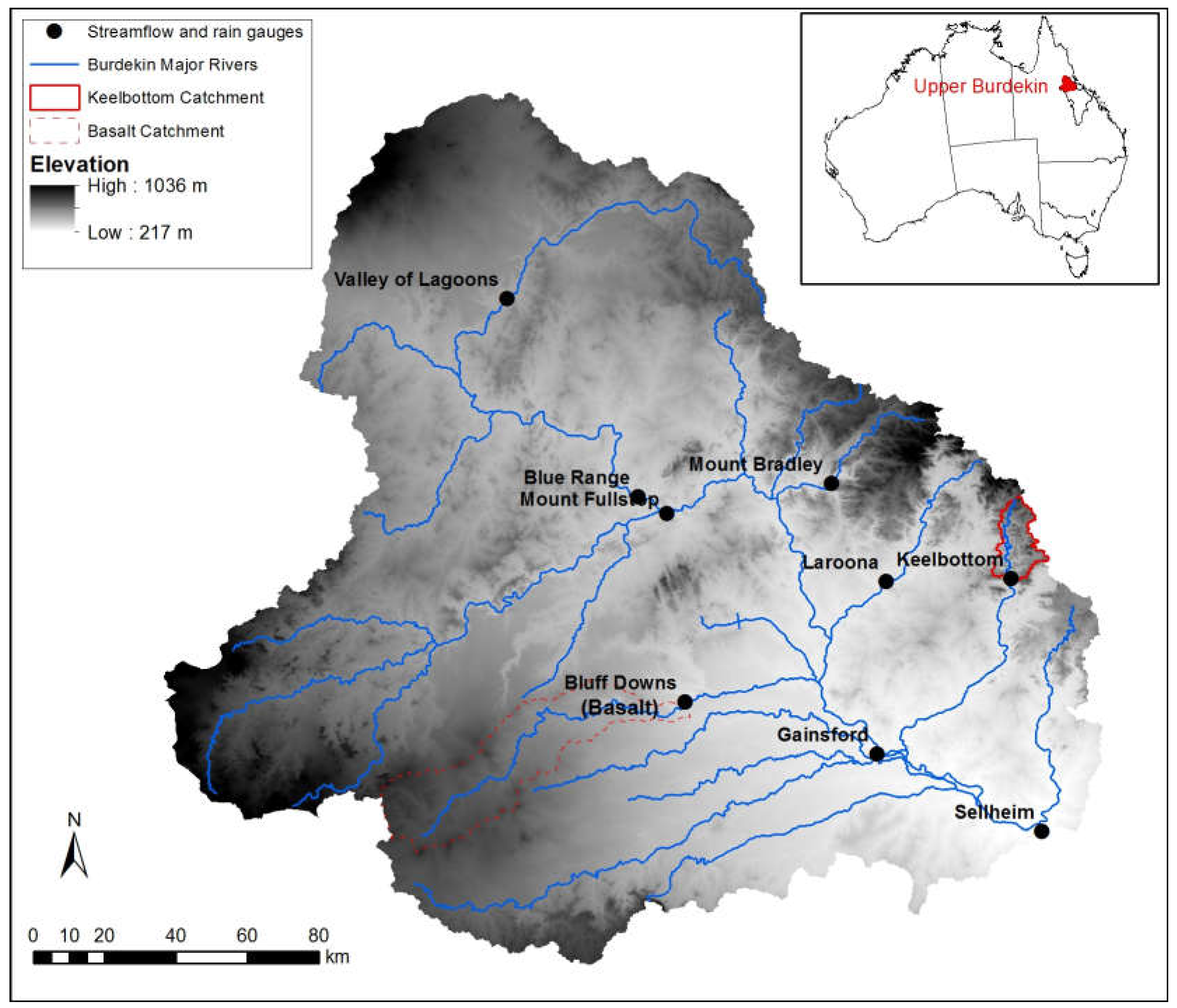


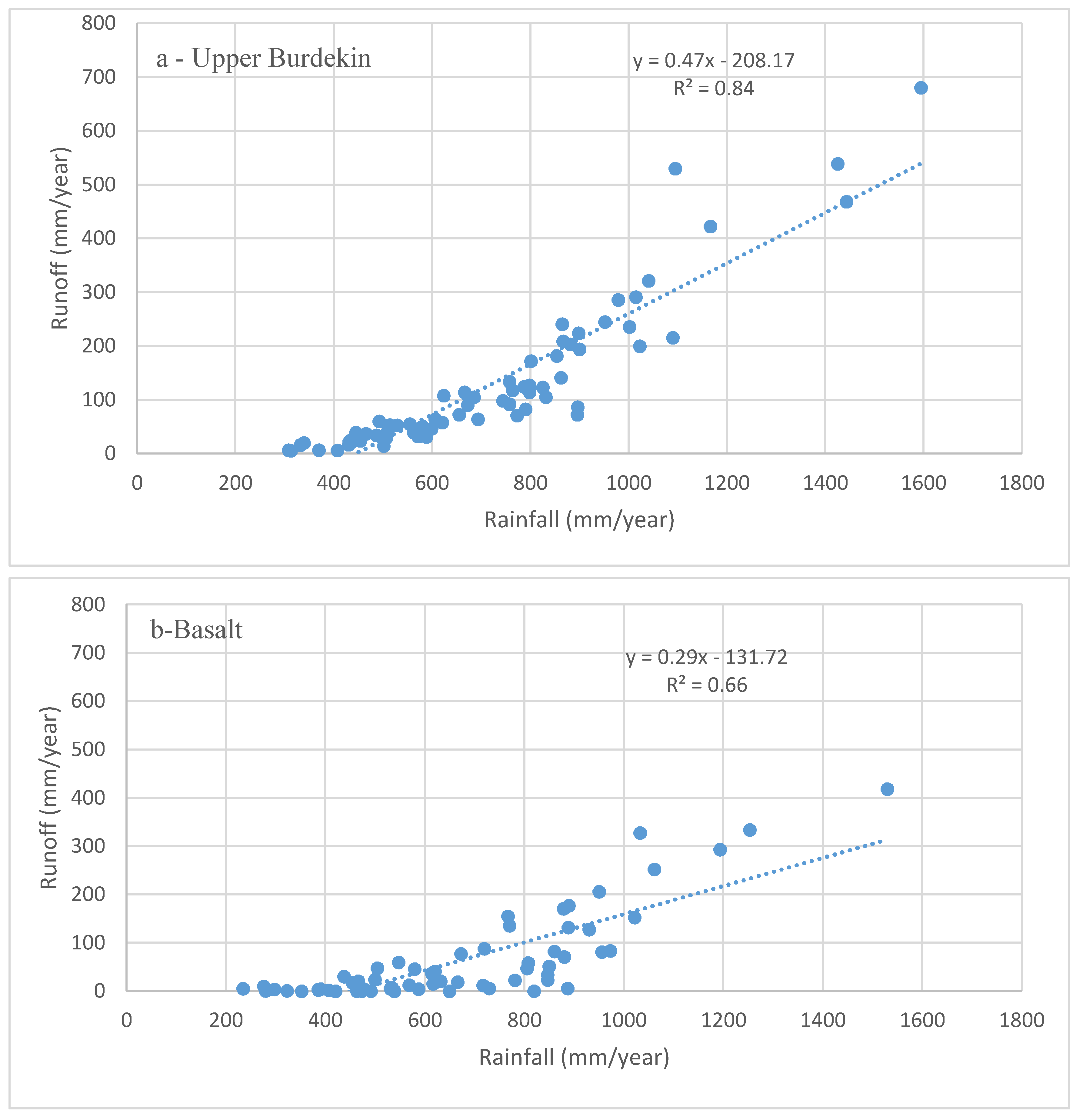
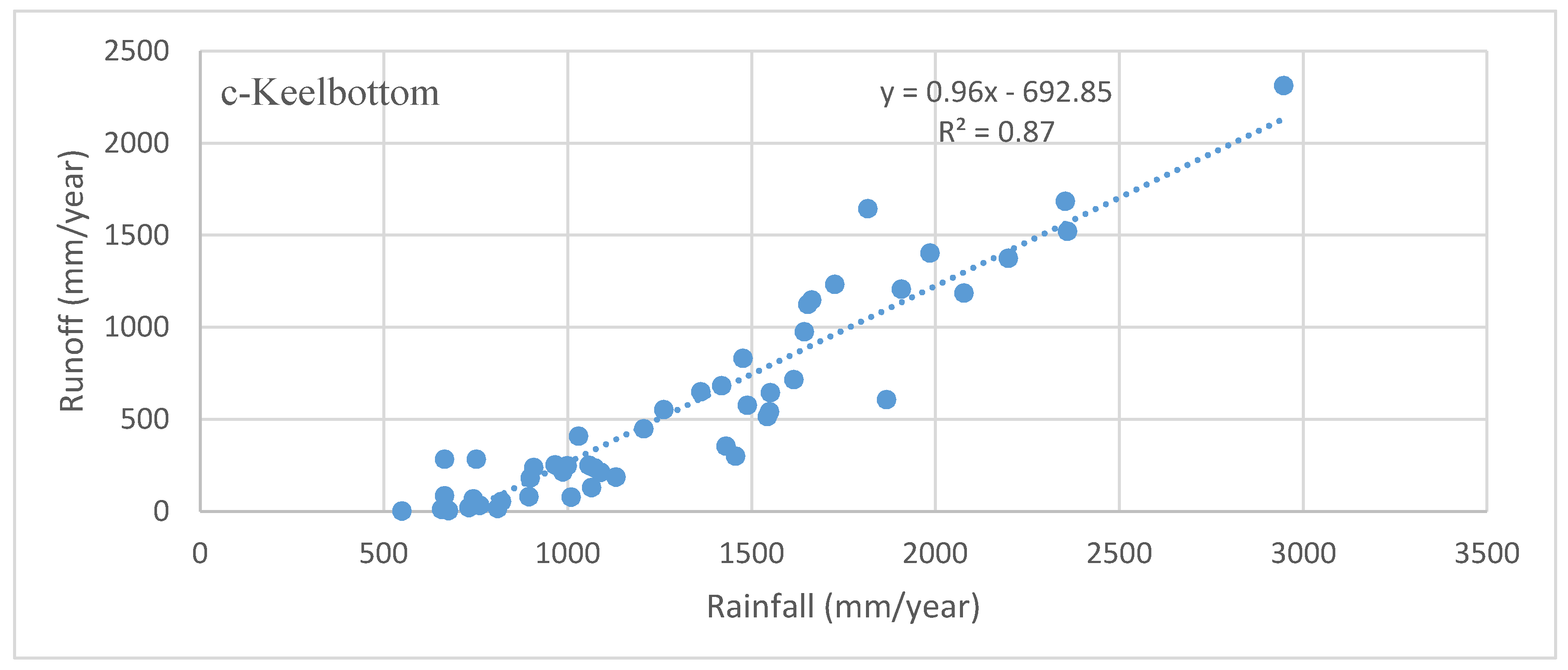
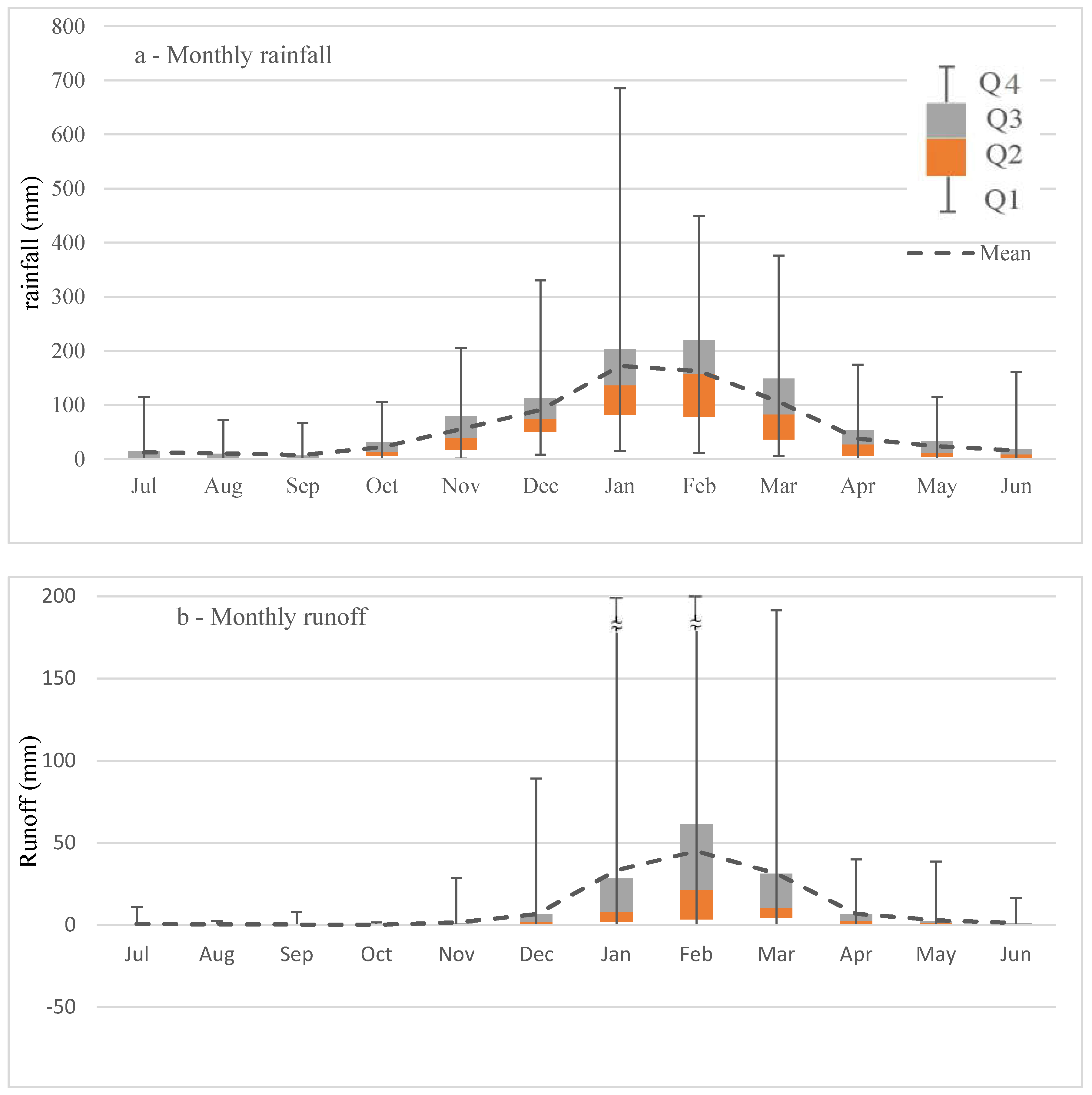
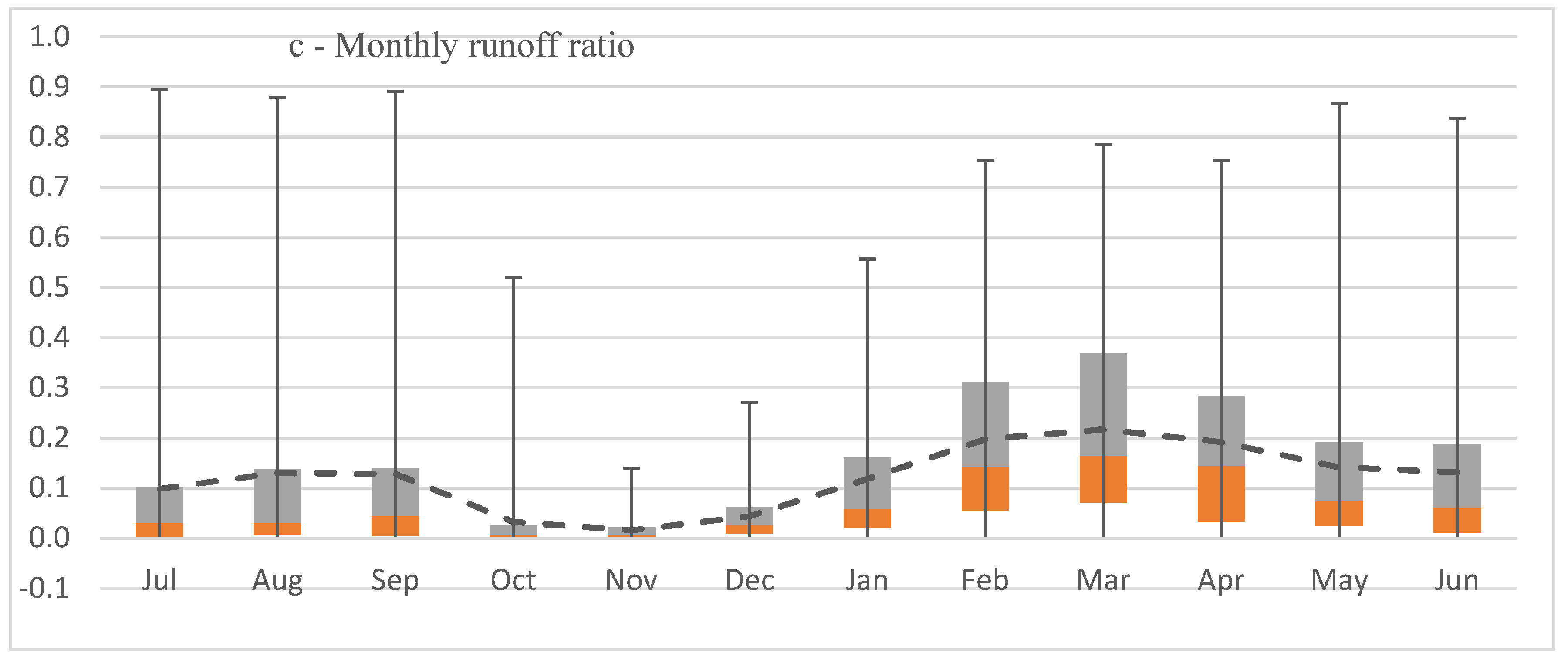
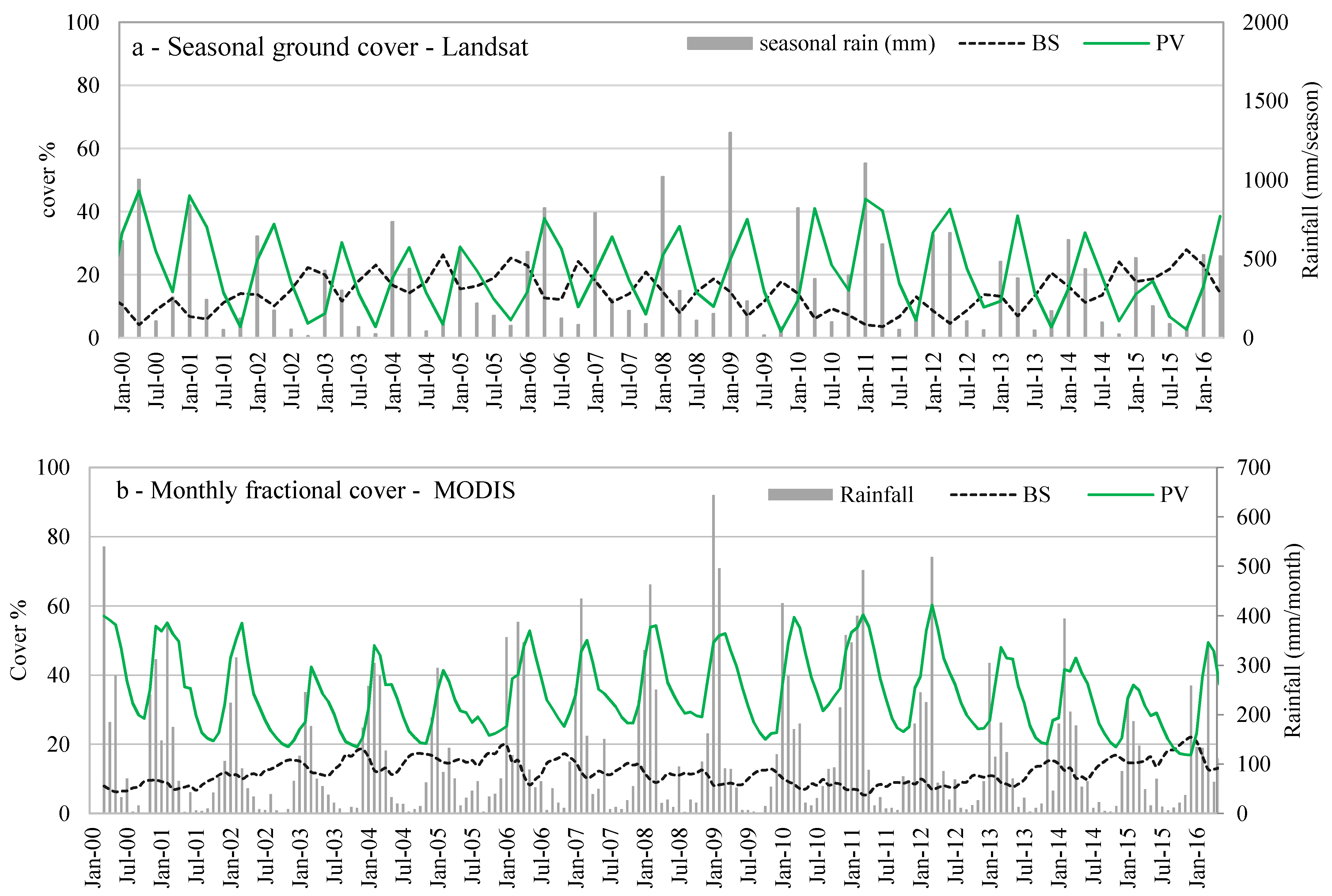
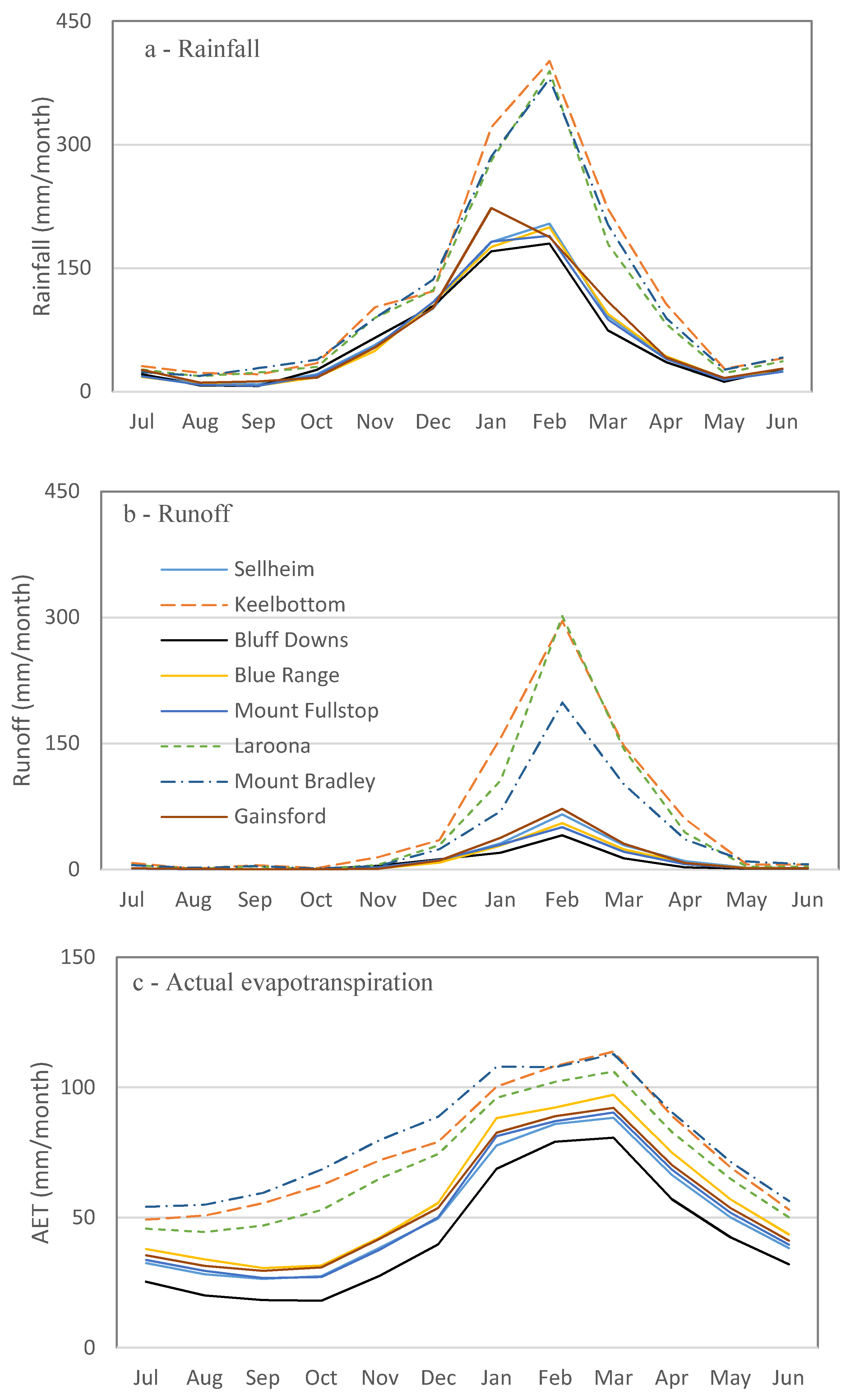
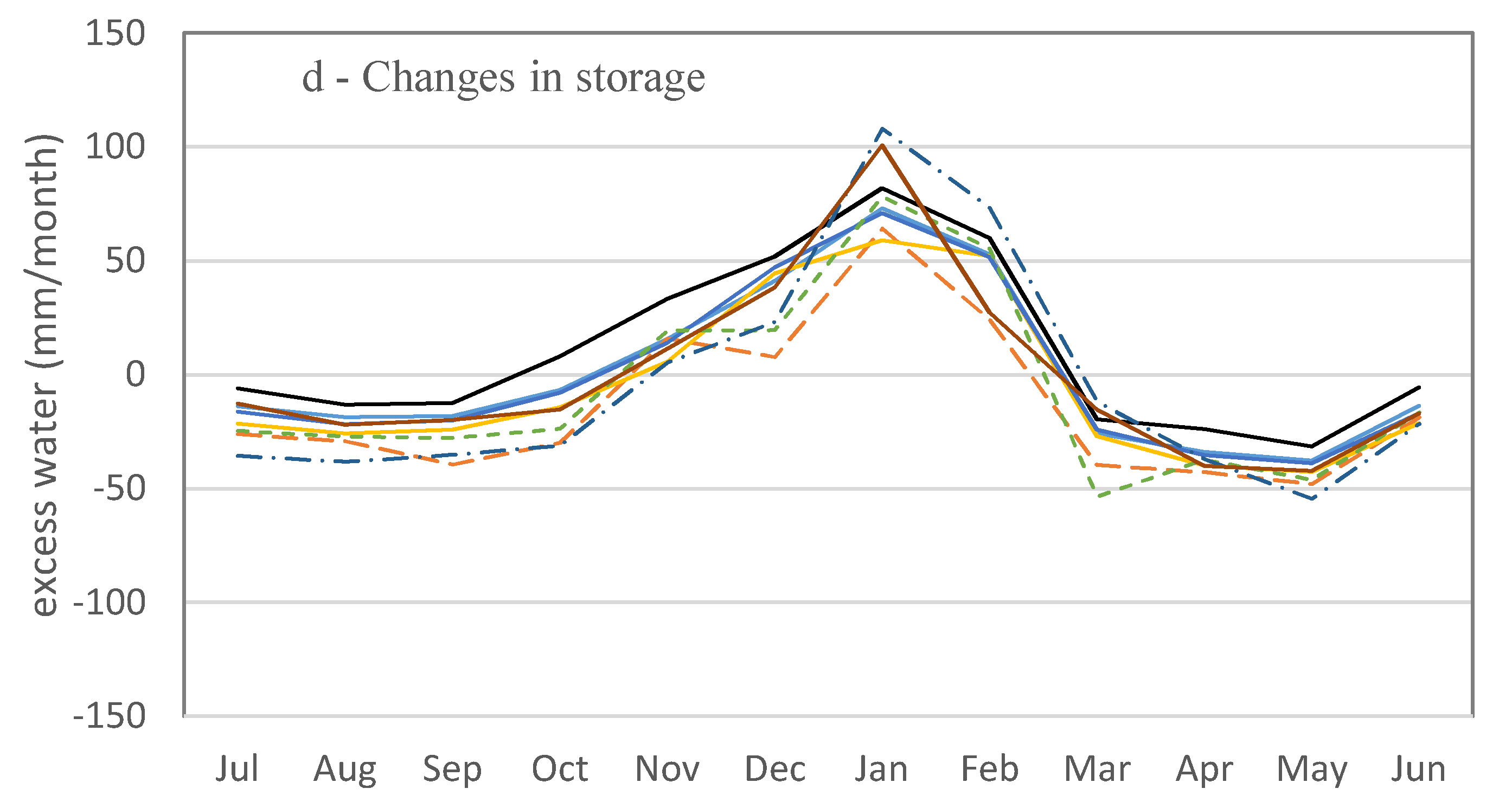
| Site Name | Site No. | River Name | Latitude | Longitude | Site Commenced | Data Period (year) | Catchment Area (km2) | Mean Annual Rainfall (mm·y−1) | Mean Annual PET (mm·y−1) | Mean Runoff Ratio % |
|---|---|---|---|---|---|---|---|---|---|---|
| Sellheim | 120002C | Burdekin | 20.01° S | 146.44° E | 1 October 1968 | 47.7 | 36,260 | 707 | 1748 | 15 |
| Keelbottom | 120102A | Keelbottom | 19.37° S | 146.36° E | 23 August 1967 | 48.8 | 193 | 1294 | 1713 | 35 |
| Bluff Downs | 120106B | Basalt | 19.68° S | 145.54° E | 1 October 1967 | 48.7 | 1283 | 664 | 1730 | 8 |
| Blue Range | 120107B | Burdekin | 19.16° S | 145.42° E | 1 October 1982 | 33.7 | 10,530 | 698 | 1738 | 12 |
| Mount Fullstop | 120110A | Burdekin | 19.21° S | 145.50° E | 16 January 1965 | 51.4 | 17,310 | 688 | 1740 | 11 |
| Laroona | 120112A | Star | 19.38° S | 146.05° E | 1 October 1967 | 48.7 | 1212 | 1172 | 1757 | 30 |
| Mount Bradley | 120120A | Running | 19.13° S | 145.91° E | 12 March 1975 | 41.3 | 490 | 1306 | 1686 | 28 |
| Gainsford | 120122A | Burdekin | 19.81° S | 146.02° E | 3 June 2004 | 12.0 | 26,320 | 721 | 1744 | 15 |
| Valley of Lagoons | 120123A | Burdekin | 18.66° S | 145.09° E | 23 October 2012 | 3.6 | 3509 | 766 | 1754 | 8 |
| Parameter | R vs. SM | R vs. GC | R vs. GC&SM | GC vs. SM | R vs. P | R vs. P&SM | R vs. P&GC | R vs. P&GC&SM |
|---|---|---|---|---|---|---|---|---|
| Multiple R | 0.34 | 0.44 | 0.45 | 0.87 | 0.90 | 0.90 | 0.91 | 0.93 |
| Adjusted R2 | 0.08 | 0.16 | 0.13 | 0.75 | 0.80 | 0.79 | 0.81 | 0.85 |
| Standard Error | 148.6 | 141.87 | 144.22 | 252.09 | 68.65 | 70.08 | 66.99 | 60.90 |
| p-Value | Intercept: 0.813 | Intercept: 0.050 | Intercept: 0.125 | Intercept: 0.000 | Intercept: 0.000 | Intercept: 0.001 | Intercept: 0.548 | Intercept: 0.027 |
| SM:0.090 | GC:0.025 | GC:0.130 | SM:0.000 | P:0.000 | P:0.000 | P:0.000 | P:0.000 | |
| SM:0.640 | SM:0.866 | GC:0.151 | GC:0.008 | |||||
| SM:0.025 |
| Parameter | P-R vs. SM | P-R vs. GC | P-R vs. GC&SM |
|---|---|---|---|
| Multiple R | 0.38 | 0.65 | 0.75 |
| Adjusted R2 | 0.11 | 0.39 | 0.52 |
| Standard Error | 172.54 | 142.09 | 125.97 |
| p-Value | Intercept: 0.002 | Intercept: 0.012 | Intercept: 0.001 |
| SM: 0.057 | GC: 0.000 | GC: 0.000 | |
| SM: 0.012 |
| Parameter | Rainfall–Runoff | Soil Moisture–Runoff | Ground Cover–Runoff | |||||||||||||||
|---|---|---|---|---|---|---|---|---|---|---|---|---|---|---|---|---|---|---|
| Month | Nov. | Dec. | Jan. | Feb. | Mar. | Apr. | Nov. | Dec. | Jan. | Feb. | Mar. | Apr. | Nov. | Dec. | Jan. | Feb. | Mar. | Apr. |
| Upper Burdekin | 0.75 | 0.92 | 0.82 | 0.81 | 0.88 | 0.73 | 0.67 | 0.78 | 0.55 | 0.72 | 0.10 | 0.47 | 0.70 | 0.76 | 0.64 | 0.48 | 0.58 | 0.57 |
| Keelbottom | 0.81 | 0.91 | 0.76 | 0.85 | 0.93 | 0.93 | 0.77 | 0.66 | 0.10 | 0.61 | 0.00 | 0.33 | 0.54 | 0.62 | 0.22 | 0.45 | 0.17 | 0.33 |
| Basalt | 0.84 | 0.91 | 0.82 | 0.74 | 0.81 | 0.49 | 0.87 | 0.65 | 0.46 | 0.53 | 0.10 | 0.28 | 0.83 | 0.71 | 0.53 | 0.39 | 0.54 | 0.50 |
| Blue Range | 0.76 | 0.91 | 0.80 | 0.79 | 0.82 | 0.85 | 0.71 | 0.85 | 0.56 | 0.70 | 0.00 | 0.24 | 0.69 | 0.79 | 0.54 | 0.35 | 0.37 | 0.42 |
| Mount Fullstop | 0.77 | 0.91 | 0.84 | 0.77 | 0.87 | 0.81 | 0.75 | 0.86 | 0.57 | 0.70 | 0.00 | 0.30 | 0.73 | 0.80 | 0.57 | 0.36 | 0.48 | 0.51 |
| Laroona | 0.77 | 0.92 | 0.82 | 0.89 | 0.96 | 0.89 | 0.58 | 0.60 | 0.20 | 0.70 | 0.10 | 0.35 | 0.63 | 0.56 | 0.39 | 0.53 | 0.47 | 0.50 |
| Mount Bradley | 0.76 | 0.93 | 0.89 | 0.84 | 0.96 | 0.83 | 0.57 | 0.66 | 0.20 | 0.74 | 0.17 | 0.28 | 0.66 | 0.55 | 0.46 | 0.57 | 0.37 | 0.33 |
| Average | 0.78 | 0.92 | 0.82 | 0.81 | 0.89 | 0.80 | 0.71 | 0.73 | 0.42 | 0.68 | 0.10 | 0.33 | 0.69 | 0.69 | 0.49 | 0.46 | 0.45 | 0.46 |
© 2017 by the authors. Licensee MDPI, Basel, Switzerland. This article is an open access article distributed under the terms and conditions of the Creative Commons Attribution (CC BY) license (http://creativecommons.org/licenses/by/4.0/).
Share and Cite
Jarihani, B.; Sidle, R.C.; Bartley, R.; Roth, C.H.; Wilkinson, S.N. Characterisation of Hydrological Response to Rainfall at Multi Spatio-Temporal Scales in Savannas of Semi-Arid Australia. Water 2017, 9, 540. https://doi.org/10.3390/w9070540
Jarihani B, Sidle RC, Bartley R, Roth CH, Wilkinson SN. Characterisation of Hydrological Response to Rainfall at Multi Spatio-Temporal Scales in Savannas of Semi-Arid Australia. Water. 2017; 9(7):540. https://doi.org/10.3390/w9070540
Chicago/Turabian StyleJarihani, Ben, Roy C. Sidle, Rebecca Bartley, Christian H. Roth, and Scott N. Wilkinson. 2017. "Characterisation of Hydrological Response to Rainfall at Multi Spatio-Temporal Scales in Savannas of Semi-Arid Australia" Water 9, no. 7: 540. https://doi.org/10.3390/w9070540
APA StyleJarihani, B., Sidle, R. C., Bartley, R., Roth, C. H., & Wilkinson, S. N. (2017). Characterisation of Hydrological Response to Rainfall at Multi Spatio-Temporal Scales in Savannas of Semi-Arid Australia. Water, 9(7), 540. https://doi.org/10.3390/w9070540





